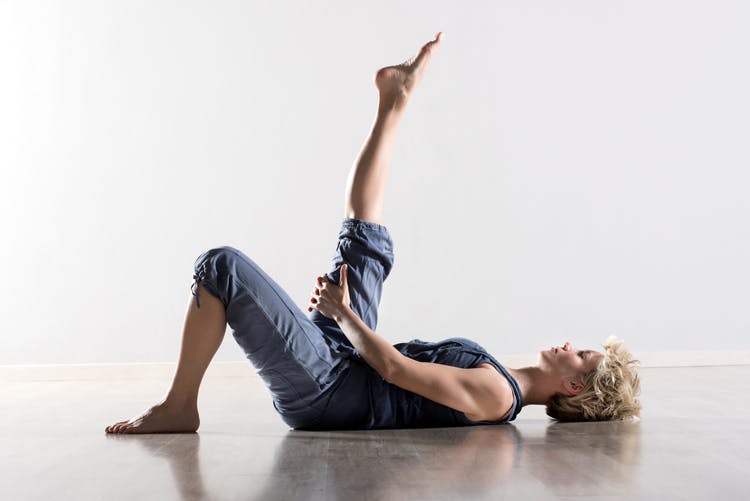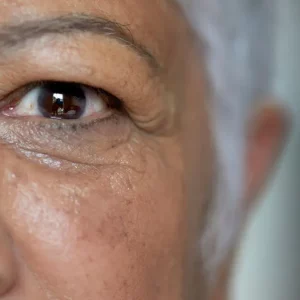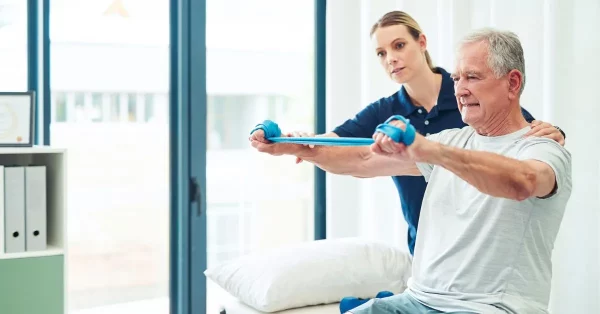Following a neurological injury, individuals experiencing muscle tightness and rigidity may benefit from spasticity treatment. Characterized by involuntary muscle contractions, spasticity is a condition that occurs due to a breakdown in communication between the brain and muscles resulting from a neurological injury.
Spasticity treatment often involves addressing the underlying neurological injury through therapeutic exercises and interventions. However, supplemental spasticity treatments focused specifically on relaxing the muscles may also be used as necessary.
This article will outline how spasticity occurs, and detail potential spasticity treatment options. Possible complications that may result from unmanaged spasticity are also described. Please use the links below to jump directly to any section of this article.
- What causes spasticity?
- Goals of spasticity treatment
- Spasticity treatment exercises
- Management options
- Potential complications
What Causes Spasticity?
Spasticity is a common secondary effect of numerous neurological conditions, including stroke, traumatic brain injury, spinal cord injury and cerebral palsy. Although spasticity is typically a result of damage to the nervous system, it manifests outwardly, presenting as tight, rigid muscles.
In healthy individuals, the brain and muscles are in constant communication, using neural pathways within the spinal cord and peripheral nerves to transmit messages. The muscles tell the brain about their current level of tension, and the brain tells the muscles how and when to move. When a neurological injury damages certain areas of the brain or spinal cord, it can impair the brain’s ability to communicate with the affected muscles.
As a result, the muscles may become “over-active” and remain in a state of involuntary contraction, formally known as spasticity. Spasticity is velocity-dependent, which means that the more rapidly a muscle is stretched, the more severely it will contract. However, spasticity can also be present at rest, as severe spasticity may cause muscles to stay in a prolonged state of contraction.
Spasticity can affect any area of the body. For example, an individual’s hand may become clenched in a fist, their arm may curl into their chest, or their toes may curl under. Severe spasticity can result in painful contractures and be functionally limiting, making treatment even more important.
What Are the Goals of Spasticity Treatment?
Spasticity treatments can be divided into two categories: (1) exercises that address the underlying cause of spasticity, and (2) interventions that address muscle tightness as a symptom. Both can play equally important roles in recovery.
Spasticity treatment exercises work by addressing damage to the nervous system. Repetitive practice of therapeutic exercises sparks neuroplasticity, which is the mechanism the brain and spinal cord use to rewire and repair themselves.
Therefore, the goal of spasticity treatment exercises is to directly improve communication between the brain and muscles by activating neuroplasticity. When the brain and muscles can communicate effectively again, the brain can tell the affected muscles to relax and contract when appropriate.
Practicing spasticity treatment exercises on a daily basis can provide the brain and/or spinal cord with the stimulation needed to promote adaptive changes. However, it can take some time for these changes to occur. This is where other spasticity treatments can help.
Certain medications like Botox and baclofen help address the symptom of spasticity. However, these drugs do not result in any lasting changes to the nervous system. Instead, they temporarily relieve the symptom of muscle tightness.
Because the results are temporary, medications often work best when they are used to create a window of opportunity to complete daily rehabilitation exercises that focus on promoting neuroplasticity. That way, short-term gains can make way for long-term results.
Addressing the Underlying Cause: Spasticity Treatment Exercises
While spasticity treatment exercises may help to stretch and strengthen the muscles, the primary objective of these exercises is to activate neuroplasticity. Over time, the adaptive changes made through neuroplasticity may help spasticity subside, allowing the affected muscles to remain relaxed unless functionally contracting.
Physical and Occupational Therapies
Because everyone experiences spasticity differently, a personalized approach to treatment is ideal. Therefore, it is recommended to work with a team of rehabilitation specialists to optimize recovery outcomes.
Physical therapists specialize in stimulating the mind-body connection through targeted exercise, modalities, and manual therapy techniques. Depending on the individual’s level of spasticity, physical therapists may recommend using passive and/or active range of motion exercises to rewire the brain. Passive range of motion exercises include stretches that require no muscular exertion, while active exercises involve independently and intentionally performing specific movements.
Occupational therapists also work on improving the communication between the brain and muscles, with a focus on promoting independence in functional tasks. Sessions may include practicing exercises and activities to spark neuroplasticity, or learning about adaptive tools and techniques to improve independence with everyday tasks.
Supplemental Therapies for Spasticity Treatment
Many therapists may recommend using supplemental therapies, such as electrical stimulation or electroacupuncture, in addition to practicing spasticity treatment exercises. While these are not designed to be stand-alone therapies, they can be used to enhance recovery outcomes.
Electrical stimulation is a type of therapy where electrical currents are applied to the affected muscles through pads placed on the skin. These electrical currents help stimulate the affected muscles, further promoting their ability to communicate effectively with the brain.
Systematic reviews have shown that electrical stimulation can reduce spasticity in survivors of both stroke and spinal cord injuries. Studies even suggest that combining electrical stimulation with therapeutic exercises can result in better outcomes than practicing exercises alone.
Electroacupuncture applies many of the same principles of electrical stimulation. However, instead of applying the electrical current through pads on the skin, the current is applied to thin needles placed in specific “acupoints” on the body. When combined with exercise, electroacupuncture has been shown to help reduce spasticity in both the upper and lower limbs.
While these supplemental therapies have the potential to enhance improvements, it is important to note that there are some contraindications. Neither electrical stimulation nor electroacupuncture should be used on individuals with an implanted pacemaker, and should be used with care on individuals with sensory impairments. It is always best to refer to one’s medical team for guidance before trying any new spasticity treatment options.
Importance of Spasticity Treatment Home Exercises
In addition to practicing exercises and using supplemental therapies during treatment sessions, most therapists will also recommend participating in a home exercise program. This is essential, as neuroplasticity is promoted through repetitious tasks.
For those who struggle with motivation to exercise outside of therapy, gamified therapeutic devices designed for home use, such as FitMi and the Music Glove, have been developed. These technologies can adapt to an individual’s skill level, providing an interactive and personalized rehabilitation experience. Regularly practicing exercises, whether through a written or technological home program, is vital to promote adaptive changes, reduce spasticity, and improve functional performance.
Addressing the Symptoms: Approaches to Managing Spasticity
While addressing the underlying cause of spasticity through therapeutic exercises is important, doctors and therapists may also recommend using spasticity treatments focused primarily on managing tight, rigid muscles. This may include using pharmacological treatments such as Botox or baclofen, or other options like wearing orthotics or even undergoing surgery.
Pharmaceutical Spasticity Treatments
When spasticity becomes severe, individuals may have limited mobility, making it difficult to practice therapeutic exercises. In this case, using Botox or baclofen be recommended by a doctor or therapist to reduce muscle stiffness.
Botox is a locally injected nerve block that can help temporarily relieve spasticity in both the upper and lower extremities. Although the effects of Botox will wear off after 3-6 months, many are able to make lasting improvements by using the short-term reduction in muscle tightness to practice daily spasticity treatment exercises.
On the other hand, baclofen is a muscle relaxant that can be taken orally or administered through a surgically implanted intrathecal baclofen pump to reduce muscle rigidity. The effects of baclofen wear off quickly, thus it needs to be administered regularly.
Side effects from both Botox and baclofen can range from mild to severe. Due to the potential for adverse effects, it is especially beneficial to practice spasticity treatment exercises while under the effects of these medications. This is because doing so addresses the root problem of disrupted communication between the brain and muscles, encouraging long-term improvements.
Orthotics
Casts, braces and splints that can help stretch spastic muscles are referred to as orthotics. Orthotics are often recommended as a temporary spasticity treatment option, as they can provide a prolonged, light stretch to tight muscles.
There are many types of orthotics available that target specific muscle groups. For example, individuals who have a clenched hand due to spasticity may use a hand splint to prop open the hand, while those with tight calf muscles may use an ankle-foot orthotic.
As with all spasticity treatments focused primarily on managing muscle tightness, it’s important to combine the use of an orthotic with therapeutic exercises. Stretching and splinting alone are not enough to fully treat spasticity. Instead, outcomes improve when orthotics and stretching are combined with additional therapeutic interventions.
Surgical Spasticity Treatments
When all of the conservative spasticity treatment options have been exhausted, doctors may recommend undergoing a surgical procedure called a selective dorsal rhizotomy. This surgery involves permanently cutting the nerve rootlets in the spinal cord that are sending abnormal signals to the muscles.
Since rhizotomies are predominantly used for individuals with cerebral palsy, its effects for individuals with other neurological injuries are still being studied. However, findings thus far are generally positive, making it a promising treatment option for individuals with neurological injuries such as stroke and multiple sclerosis.
Complications of Unmanaged Spasticity
Stretching spastic muscles on a daily basis is vital for managing spasticity. Slow, gentle stretches are most effective, since spasticity increases the faster the muscles is stretched. Never stretch to the point of pain, since this may cause further complications.
When individuals do not stretch or exercise on a regular basis, they are at an increased risk of complications. One of the most common complications of unmanaged spasticity is the development of contractures. Often a painful condition, contractures are characterized by extreme stiffness in the muscles, joints, or connective tissue. This may result in an inability to use the affected area of the body.
Individuals with severe spasticity are also at risk of pressure ulcers due to limited mobility and the potential for having prolonged moisture in contracted areas. This is especially true among those who are bedridden or rely on wheelchairs for mobility. Along with stretching, ensuring that individuals are regularly repositioned for pressure relief is essential to reduce the risk of this complication.
With these complications in mind, it is easy to see why spasticity management is essential. Regularly practicing spasticity treatment exercises, along with using supplemental therapies and management techniques as needed, is the most effective way to relieve spasticity and reduce the likelihood of complications.
Understanding Spasticity Treatments
Spasticity is a condition characterized by rigid, stiff muscles stemming from miscommunication between the brain and muscles after a neurological injury. Exercise is a great spasticity treatment option because it sparks neuroplasticity and helps repair the communication between the brain and muscles.
Using supplemental spasticity treatments, such as electrical stimulation and Botox, can enhance improvements. Consistently stretching and exercising affected muscles is generally the most effective way to reduce the risk of complications and relieve spasticity. While the spasticity treatment options described above are effective for many individuals, consulting with a doctor or therapists can help individuals learn which treatments options may be most effective for their specific condition.

















